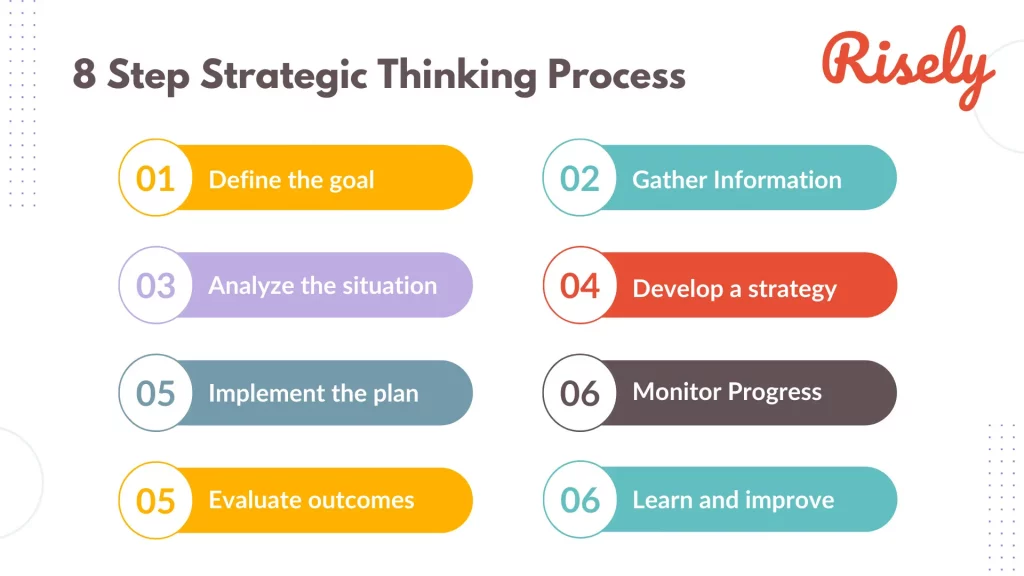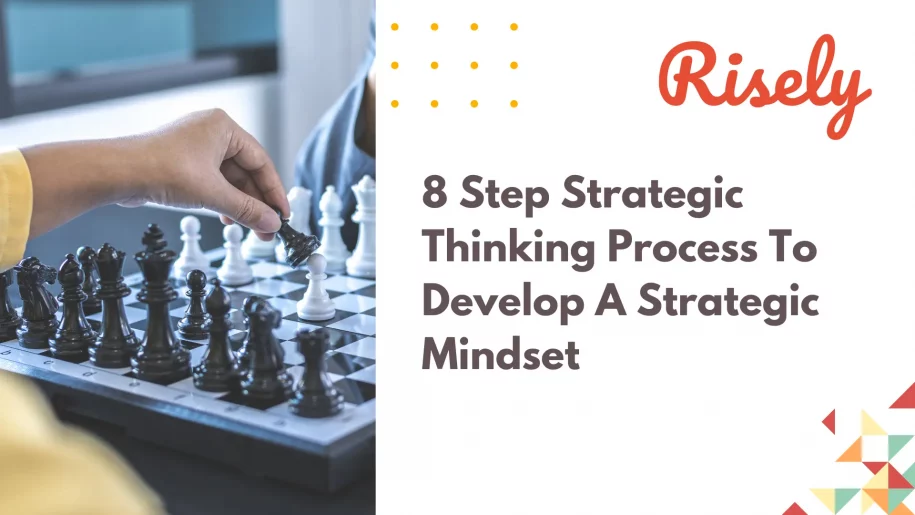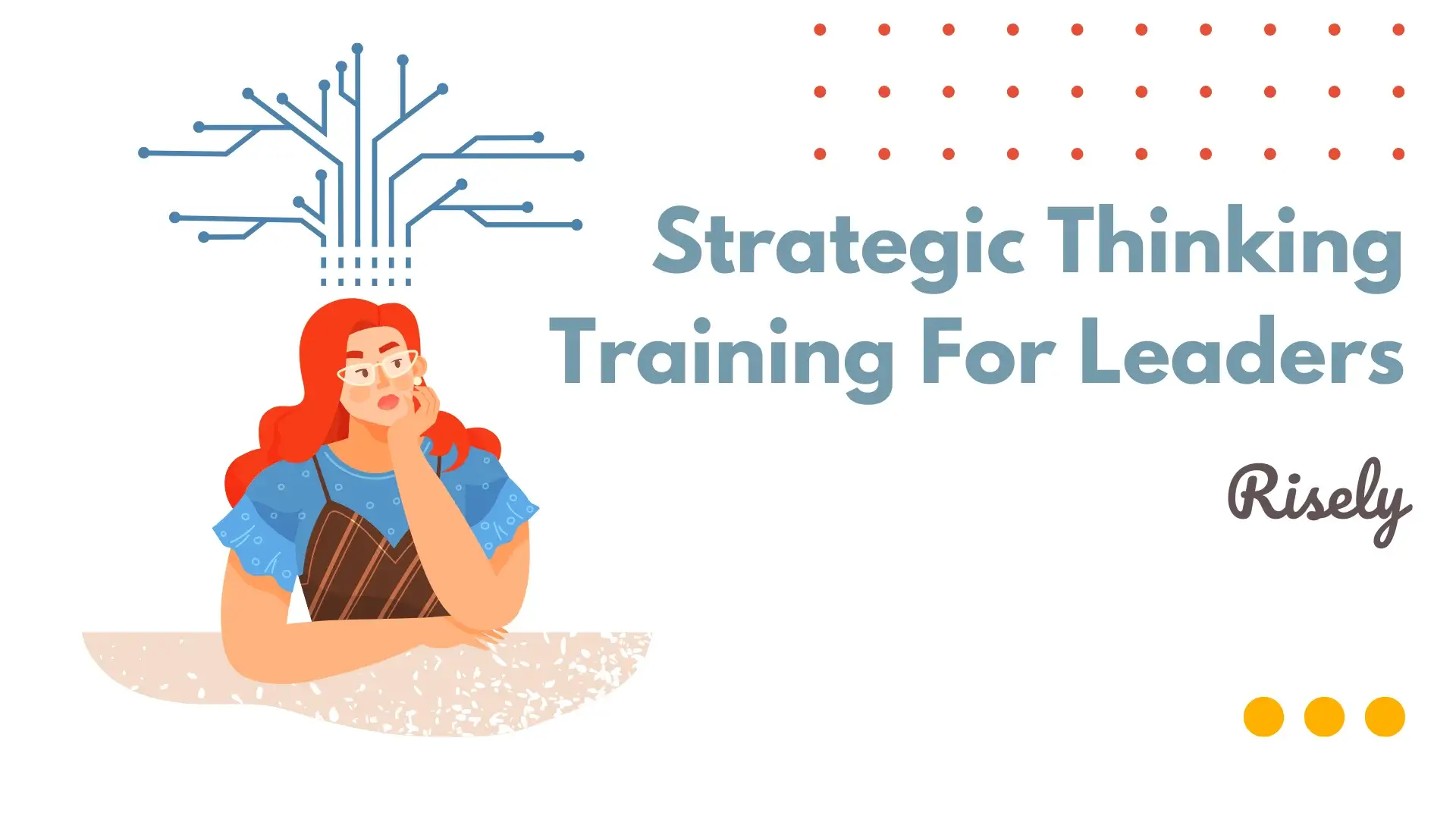8 Step Strategic Thinking Process To Develop A Strategic Mindset
A strategic thinker is the visionary who, before sailing into the unknown, plans for all possible scenarios and prepares a course of action. The strategic thinker is constantly thinking ahead and planning to improve the future. Strategic thinking skills help you plan and imagine different possibilities. Strategic thinking is an essential skill that every individual should possess, especially in the present day and age, where everything happens quickly. Strategic thinking skills allow individuals to foresee the consequences of their actions and make sound decisions that benefit them in the long run. In this blog, we talk about strategic thinking process, strategic mindset, and how you can develop it.What is Strategic Thinking?
Strategic thinking is a thought process focused on analyzing critical factors or variables that may influence the long-term success of a business, team, or individual. It involves planning, seeing the big picture, and putting thought into action to gain a competitive advantage in the industry. Strategic thinking process involves setting a clear goal and planning to reach it while accounting for economic realities, market forces, and available resources. In essence, strategic thinking is an intentional and rational process that requires research, analytical thinking, innovation, problem-solving skills, communication and leadership abilities, and decisiveness.8 Step Strategic Thinking Process
Strategic thinking process is analyzing, evaluating, and planning to achieve a long-term goal or objective.
- Define the goal: The first step in the strategic thinking process is to define the goal or objective that you want to achieve. This should clearly and clearly state what you want to accomplish.
- Gather information: Once you have defined your goal, you must gather information to help you make informed decisions. This may involve researching the market, analyzing data, and gathering stakeholder feedback.
- Analyze the situation: After gathering information, the next step is to analyze the situation. This involves identifying strengths, weaknesses, opportunities, and threats (SWOT analysis) that may impact the success of your plan.
- Develop a strategy: Based on the analysis, you can develop a strategy that outlines the steps you need to take to achieve your goal. Your strategy should be specific, measurable, achievable, relevant, and time-bound (SMART).
- Implement the plan: Once you have developed your strategy, you must implement it. This involves allocating resources, setting timelines, and assigning responsibilities to individuals or teams.
- Monitor progress: As you implement your plan, it is essential to monitor progress regularly. This allows you to identify any issues or challenges and adjust as needed.
- Evaluate outcomes: After implementing your plan, you should evaluate the outcomes to determine whether you achieved your goal. This can involve analyzing data, gathering feedback, and assessing the impact of your plan on stakeholders.
- Learn and improve: A step that continuously keeps happening in strategic thinking process includes learning from your experience and using the insights gained to improve future plans is essential. This involves identifying what worked well and did not and adjusting your approach as needed.
Benefits of Being a Strategic Thinker
Strategic thinking can lead to better decision-making, problem-solving, innovation, leadership, resource management, and adaptability. These skills are highly valued in many fields and can help individuals succeed personally and professionally. There are several benefits of strategic thinking, including:- Better decision-making: Strategic thinkers can analyze situations and identify the best action, leading to better decision-making and outcomes.
- Improved problem-solving: Strategic thinkers are skilled at identifying problems, developing solutions, and implementing strategies to solve complex issues.
- Increased innovation: Strategic thinkers are creative and innovative, constantly exploring new ideas and approaches to improve performance and achieve goals.
- More decisive leadership: Strategic thinkers can see the big picture and develop a clear vision, which can help them inspire and motivate others to achieve shared objectives.
- Better resource management: Strategic thinkers are adept at managing time, money, and people, to achieve desired outcomes efficiently and effectively.
- Enhanced adaptability: Strategic thinkers can anticipate and respond to changes in the environment, enabling them to adapt quickly and effectively to new situations.
Other Interesting Reads
What is a Strategic Mindset?
A strategic mindset is a way of thinking that involves analyzing situations, identifying opportunities and challenges, and developing a long-term plan to achieve a specific goal. It is a proactive and forward-thinking approach that consists of considering both short-term and long-term outcomes and considering all the factors that may impact the success of a plan. A strategic mindset involves the following which help in making the strategic thinking process much easier:- Big-picture thinking: Strategic thinkers can see the big picture and consider all the factors that may impact the success of a plan. They analyze data, assess risks, and consider different scenarios before making decisions.
- Creativity and innovation: Strategic thinkers are creative and innovative, constantly seeking new and better ways to achieve their goals. They are not afraid to take risks and experiment with different approaches.
- Flexibility and adaptability: Strategic thinkers can adapt quickly to changing circumstances and adjust their plans accordingly. They are comfortable with ambiguity and uncertainty and can pivot their strategies as needed.
- Focus on outcomes: Strategic thinkers focus on outcomes and results rather than just completing tasks. They are driven by a desire to achieve specific goals and are willing to put in the effort required to achieve them.
- Collaborative mindset: Strategic thinkers understand that achieving success requires collaboration and teamwork. They can work with others to achieve shared objectives and are skilled at building relationships and partnerships.
How Can Managers Develop a Strategic Mindset?
Developing a strategic mindset is an essential skill for managers who want to be successful in today’s complex and rapidly changing business environment and make the strategic thinking process hassle free for themselves. Here are some ways managers can develop a strategic mindset:- Focus on the big picture: Managers should develop the ability to see beyond day-to-day operations and focus on the bigger picture. They should consider how today’s decisions will impact the organization’s long-term goals.
- Embrace change: A strategic mindset requires managers to be comfortable with change and uncertainty. Therefore, managers should be open to new ideas and be willing to adapt their approach to changing circumstances.
- Analyze data: To make informed decisions, managers need to be able to analyze data and identify trends. They should understand the organization’s key performance indicators (KPIs) and use data to guide their decisions.
- Develop a vision: A strategic mindset requires managers to have a clear vision for the organization’s future. Managers should be able to articulate their vision and communicate it effectively to their team.
- Build a strong team: Strategic thinking is a collaborative process. Therefore, managers should build a strong team that includes individuals with diverse skills and perspectives.
- Be proactive: A strategic mindset requires managers to be proactive rather than reactive. Managers should anticipate potential challenges and opportunities and take action to address them before they become problems.
- Learn continuously: A strategic mindset requires managers to be lifelong learners. Therefore, managers should be open to new ideas and actively seek opportunities to develop new skills and knowledge.
- Seek feedback: To develop a strategic mindset, managers should seek feedback from their team, colleagues, and stakeholders. They should be open to constructive criticism and use it to improve their approach.
Conclusion
Strategic thinking is not just thinking out of the box but also beyond the box. Developing a strategic mindset and following a strategic thinking process are essential skills for individuals and organizations looking to achieve long-term success. A strategic perspective requires a focus on the bigger picture, the ability to analyze data and identify trends, and a willingness to embrace change and take proactive action. Strategic thinking process involves defining the goal, gathering information, analyzing the situation, developing a strategy, implementing the plan, monitoring progress, evaluating outcomes, and learning and improving. By adopting these practices, individuals and organizations can make informed decisions and take purposeful action toward their goals.Develop the growth mindset to create ambitious strategies!
Download the free growth mindset toolkit for managers to get started today.
FAQs
What are the 6 Ps of strategic thinking?
The six Ps of strategic thinking includes considering six key areas: People, Process, Product, Platform, Price, and Positioning. Strategic thinkers must be able to use the left (logical) and right (creative) sides of their brains to understand the problem and potential solutions fully. Furthermore, strategic thinking requires a clearly defined and focused vision that can be adjusted as the business landscape changes.
What is the mindset of a strategic leader?
A strategic leader has the mindset of a problem-solver. They can anticipate potential problems and plan, which allows them to take proactive steps to address any potential issues. In addition, strategic leaders possess a curious mind, unafraid of challenging conventional thinking and asking the right questions. They are also flexible and can pivot when a course of action does not yield the desired results. Last but not least, strategic leaders must possess the skills to think critically, anticipate, interpret, decide, define objectives, align processes, and learn from results.
What are the steps of the strategic thinking process?
Strategic thinking involves defining the goal, gathering information, analyzing the situation, developing a strategy, implementing the plan, monitoring progress, evaluating outcomes, and learning and improving. These steps enable individuals and organizations to make informed decisions and take purposeful action toward their goals.
Other Related Blogs
Strategic Thinking Training For Leaders Simplified
Strategic Thinking Training For Leaders Simplified Strategic thinking is a vital skill for business leaders, managers, and employees in today’s fast-paced, competitive world. It goes beyond day-to-day tasks and involves…
10 Best Strategic Thinking Coaches to Speed Up Your Growth
10 Best Strategic Thinking Coaches to Speed Up Your Growth In the fast-paced and ever-evolving business landscape, strategic thinking has become more than just a desirable trait; it’s a critical…
5 Powerful Skills to Become an Exceptional Business Leadership Coach
5 Powerful Skills to Become an Exceptional Business Leadership Coach In the world of business, leadership is of paramount importance. It is something that makes all the difference. With so…
8 Strategic Thinking Examples to Help You Succeed
8 Strategic Thinking Examples to Help You Succeed Strategic thinking is an essential skill that leaders and managers must possess to steer their teams toward success. It involves analyzing situations,…


